From 2 December 2014 to 1 February 2015, Palazzo Reale in Milan hosts Strade/Ways, the never-before-seen exhibition/installation by the great Israeli director Amos Gitai, created specifically for the Sala delle Cariatidi.
Film sequences, photographs, documents, antique carpets and visual and sound devices make up the work which draws inspiration from three different paths. The first is the movie Lullaby to my father, dedicated to the life of his father, the Bauhaus architect Munio Weinraub who, forced to flee from the Nazis, moved to Palestine and played a decisive role in the birth of Israeli architecture; the second is the conversation between Gitai and the great Milanese photographer Gabriele Basilico, on photography, architecture, film scenarios free zone dedicated to a place/non-place they reached together; the third, which occupies the entire room of the Caryatids, reconstructs the process that leads to the birth of Carpet, the director's new film, whose shooting has not yet begun.
The exhibition itinerary starts from the film Lullaby to my father which Gitai dedicated to his father, the famous architect, Munio Weinraub. Arriving at the age of 18 at the Bauhaus in Dessau, the extraordinary school directed by Gropius, he participates in the life of that place of study and research, where he also meets and works with Kandinsky and Mies van der Rohe, as evidenced by the correspondences that came to light during the making of the film. In June 1933, after having participated in the short Bauhaus season in Berlin, Munio was condemned as a "traitor to the German people" and forced to emigrate to Switzerland before moving to Haifa where he conducted his professional activity, without ever forgetting the teachings and the rigor of the school that trained him. Gabriele Basilico fixes the many buildings built in Israel in photography and his son's poem, which gives the film its title, addresses his memory as a man and architect.
free zone it's a road movie which talks about the meeting of three women, an American (Natalie Portman), an Israeli (Hanna Lazslo) and a Palestinian (Hiam Abbas), in that free zone, east of Jordan, where peace reigns without any barrier between States. Some images taken from the film are exhibited, as well as extracts from the long conversation between Gitai and Gabriele Basilico, which took place during the journey that the two had undertaken in those very places, which embraces themes such as architecture, photography and cinema.
The section of free zone introduces the majestic room of the Caryatids where Gitai has set up a fascinating journey of large photographs, very rare carpets, projections and sounds around the theme of his next film, Carpet, whose unpublished screenplay is published in the exhibition catalogue.
The film will tell the story of a carpet backwards, from the auction house where it was auctioned to the place of its production, through images of places, landscapes, peoples and people collected throughout the journey.
In this enthralling and exciting setting, some extraordinary carpets, chosen by Moshe Tabibnia in his collection, will mark the passages of places, cultures, histories and peoples who live and travel between the Mediterranean and the Orient.
"Carpet – says Gitai – proposes a journey to different territories and at the same time represents a concrete object, i.e. a beautiful carpet, the result of age-old traditions and craftsmanship, but also a metaphor for the relationships that have been woven over the centuries between oriental peoples as well as between East and West".
Jean Kalman contributed to the lighting project for the exhibition, busy these days with the lighting of Fidelio, a work that will open the Scala season.
The suggestions suggested by the room of the Caryatids, whose decorations were partly destroyed during the Second World War, led Gitai to use the ceiling as an ideal projection screen. The director himself states that “with its partly lost statues and antique mirrors, this truly magnificent room exudes a special charm. And it is precisely here that I decided to install the projections. I didn't want plasma screens: for me it was important that the excerpts were projected not on screens but directly on the ceiling, so that viewers could become aware of this room and its history. The screen is made up of the building itself. The context is important: this applies to both films and exhibitions. And by context I mean both the material conditions and the socio-political background”.
The initiative is promoted by the Municipality of Milan-Cultura and produced by Royal Palace, GAmm Giunti e Moshe Tabibnia Study Center.





